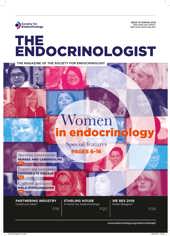Oxford Desk Reference: Endocrinology Helen E Turner, Richard Eastell & Ashley Grossman (Eds) 2018, Oxford University Press, 544 pp, Hbk, £70, ISBN 978-0-1-9967283-7
Most of us will only buy a single major textbook during our training, which needs to pass the following key tests. Is it affordable? Is it approachable: a ‘good read’? Is it comprehensive and up to date? Would I instinctively turn to it, rather than Googling a recent free-to-download review article?
We believe that this book fulfils all these requirements, and so we recommend it to fellow trainees in endocrinology, for whom it will fill a critical gap in their educational needs.
Divided into 21 chapters, it covers the full range of endocrine conditions that we encounter in everyday clinical settings. The mostly traditional format of chapters defined by hormone systems is accompanied by several unique chapters, including hormone resistance syndromes, endocrinology of different age groups, patient advice and reference, speedy reference and a short chapter on medico-legal aspects of endocrinology.
To avoid repetition, some subjects are not covered in the relevant main chapters, e.g. resistance to thyroid hormones is covered in depth in chapter 16 ‘Hormone resistance syndromes’ rather than in chapter 2 ‘Thyroid hormone metabolism’, but when you get used to the layout it’s very straightforward. The indexing is very well done, which makes finding subjects very easy.
Each chapter is subdivided into sections, which are concise and to the point. Crucially, the relative references are given after each section, so that each is a coherent piece of information and learning. More than 100 national and international experts contributed expert first-line advice, and their contributions have been seamlessly integrated by the editors.
Apart from very few figures that needed to be in colour, the book is monochrome throughout, but we all live in a technicolour world and we hope that future editions will be able to offset the costs of colour figures against economies of scale arising from a bigger print run.
An area meriting specific commendation is section 1.4 ‘Hormone measurements’, which provides an excellent explanation of hormone action and the different types of immunoassay (of great value particularly for lab-naïve clinicians). Having said that, some relevant information (e.g. causes of interference, false-positives and false-negatives) was not covered here, instead appearing in chapter 18 ‘Endocrine investigations, nursing and dietetics’.
Chapter 19 ‘Patient advice and reference’ has some diagrams that clinicians might find extremely helpful when explaining conditions to patients. The ‘Speedy reference’ (chapter 20) is a great innovation, although many more conditions could usefully have been added to the benefit of endocrine trainees and nurses and, perhaps, even generalist physicians.
This is an easy-to-read, authoritative and practical handbook, which will be very useful for clinical practice and exam revision (e.g. SCE or MRCP part 1 and 2). It is also excellent value for money. As it’s the kind of book that, once loaned out, will somehow never get returned to consultant or departmental bookshelves, we simply recommend investing in a personal copy.
Azmi Mohammed and Eltayeb Abdelaziz, South Tees Hospital NHS Foundation Trust






